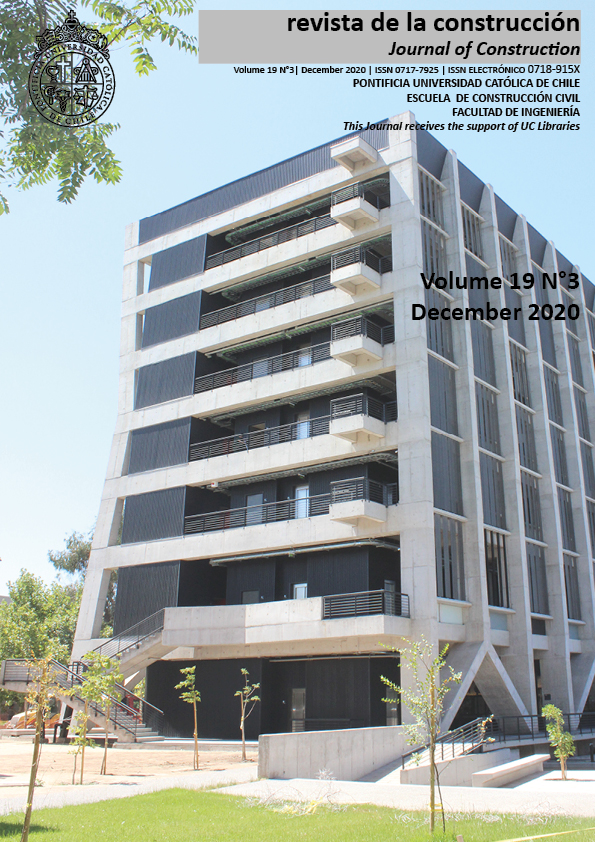Structural analysis of earth construction’s vaults: Case of underground tombs of Chogha Zanbil
DOI:
https://doi.org/10.7764/rdlc.19.3.366-380Keywords:
Chogha Zanbil, earth construction, structural analysis, underground tomb, vault.Abstract
The 3300-year-old Chogha Zanbil is the largest and best-preserved five levelled pyramidal earth ziggurat outside Mesopotamia, which was inscribed on UNESCO’s World Heritage List. Underground tombs of Chogha Zanbil are accepted as outstanding instances in Iran and consist of vaults, which are built with special methods by Elamite architects. In this context, the main purpose of this paper is to contribute to sustain the outstanding universal value of the Chogha Zanbil. For that purpose, this paper puts forward a structural analyse of the vaults of five Chogha Zanbil underground tombs, which were built inside the ground by brick, lime mortar, plaster and bitumen materials. Data for underground tombs and vaults were collected upon field observations and literature study. SAP software was used to determine the way the forces are transmitted through the vaults, the conditions of bending moments, the shear forces. As a result, it has been observed that the bending in the vaults turns into pressure force that is perfectly resisted by bricks. In conclusion, it was ascertained that the vaults of the Chogha Zanbil underground tombs were built with the right techniques at that time, so that the vaults still have solid behaviour after thousands of years and remained completely healthy to this day.
References
Amiet, P. (2018). Chogha Zanbil. In Oxford Art Online. doi:10.1093/gao/9781884446054.article.t017332
Amiet, P., & Potts, D. T. (2008). The Archaeology of Elam: Formation and Transformation of an Ancient Iranian State. American Journal of Archaeology. doi:10.2307/507206
Besenval, R. (2000). Technologie de la voute dans l’orient ancien. (M. Habibi, Ed.). Tehran: Iran Cultural Heritage Organization (Research Center) in cooperation with the French association of Iranology in Iran.
Chogha Zanbil World Heritage and Haft Teppe Museum. (n.d.).
Fadayi, H. (2002). Brick studies in the last three years.
Golabchi, M., & Javani Dizchi, A. (2016). Iranian Architectural Technology. Tehran: Tehran University.
Heidari, B. (2010). Tomb No. 5 restoration plan (Chogha Zanbil). Islamic Azad University Central Tehran Branch.
Hinz, W. (1964). Das Reich Elam (Originalau). Stuttgart: W. Kohlhammer. Retrieved from https://books.google.com/books?id=SvAyAAAAMAAJ
Hosini, S. H. (2002). The method of using bitumen mortar in Chogha zanbil monument.
Majidzade, Y. (2008). The History and Civilization of Elam. Tehran: University Publication Center.
McMahon, A., & Potts, D. T. (2001). The Archaeology of Elam: Formation and Transformation of the Ancient Iranian State. Journal of the American Oriental Society. doi:10.2307/606687
Pirnia, M. K. (1992). Dome Glossary. Athar Journal, 12(20), 140–152. Retrieved from journal.richt.ir/athar/article-1-393-fa.html
Salehvand, Navid, Shishegar, A., & Firoozmandi Shireh jin, Bahman. (2019). A Research on Tubular Glass Rods of Untash-Napirisha Doors and Their Analysis by X-Rey Fluorescence Method. Pazhoheshha-Ye Bastan Shenasi Iran. doi:10.22084/nbsh.2017.12764.1560
Tavakoli, L. sadat. (2006). The plan of restoration and instauration of the underground tombs of medieval Eam is a case study of the tomb number 5. Islamic Azad University Central Tehran Branch.
Yordanov, V., Mostafavi, A., & Scaioni, M. (2019). Distance-Training for image-based 3d modelling of archeological sites in remote regions. In ISPRS Annals of the Photogrammetry, Remote Sensing and Spatial Information Sciences. doi:10.5194/isprs-Archives-XLII-2-W11-1165-2019
Young, T. C., & Ghirshman, R. (1969). Memoires de la Delegation Archeologique en Iran. Tome XXXIX. Mission de Susiane. Tchoga Zanbil (Dur-Untash). Vol. I. La Ziggurat. American Journal of Archaeology. doi:10.2307/503523
Zalaghi, A. (2018). Digging up the Past: Revisiting the Elamite Underground Vaulted Tombs at Tappeh 497 (KS 53?), Susiana Plain. Elamica, 8.
Zomorshidi, H. (2008). Vaults and Arches in Iranian Architecture. (S. Meshki & M. Kazemi, Eds.) (First edit). Tehran: Urban Development and Revitalization Company of Iran press.





